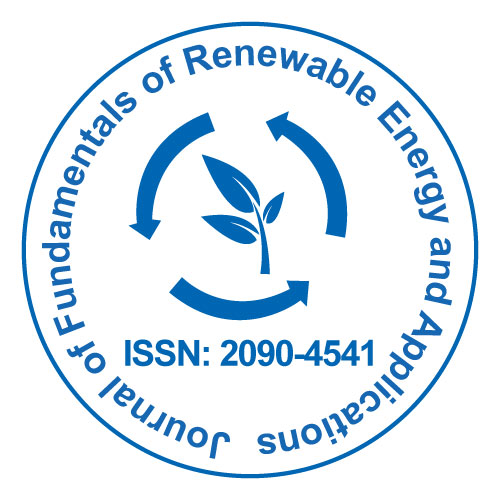
Journal of Fundamentals of Renewable Energy and Applications
Open Access
ISSN: 2090-4541

ISSN: 2090-4541
Godwin Onyedim1 and Awoyemi M O2
1Federal University Otuoke, Nigeria 2Obafemi Awolowo University, Nigeria
Scientific Tracks Abstracts: J Fundam Renewable Energy Appl
The Curie Point Depth (CPD), sedimentary thicknesses and heat flow maps of parts of the Chad basin, Nigeria were generated through the analysis of radial log power spectral of twenty-five overlapping square blocks of high resolution aeromagnetic data (HRAD). This was with a view to appraising the geothermal and hydrocarbon potential of the study area. 2D forward modeling of profiles across the CPD map and the anomalous zones of the Reduced-to-the-Equator map of the HRAD was carried out to obtain five models of the magnetic crust in the study area. The magnetic anomalies trend mainly in the NE�¬-SW, E-W and ENE-WSW directions for which the NE-SW orientation predominated. The CPDs range between 3.0 km and 16.7 km. Shallow CPD (<3.5 km) zones were identified at the extreme edges of the north-western and south-western portions. The sedimentary thicknesses in the study area ranged between 1 km and 3 km. The geothermal gradient varies between 34�°C/km and 173�°C/km and heat flow between 87 and 446 mW/m2 indicating high vertical temperature gradients and geothermal heat flow in parts of the Chad basin. The high heat flow zones situated at the extreme edge of the north-western and south-western parts of the study area are likely to constitute valuable geothermal resources. The magnetic forward models revealed the variation of the basement topography with smoother Curie point isotherm level and the presence of sub-basins in the study area. Basement rocks in regions of shallow CPD were found to have richer magnetic contents than those in regions of deep CPD. The study concludes that dry oil wells encountered in the Nigerian sector of the Chad basin in the past could have been the consequence of prevailing high magnitude of geothermal heat flow (>200 nQ/m2) resulting from shallow depths to the Curie isotherm in various parts of the study area.
Godwin Onyedim is a Professor at the Faculty of Sciences, Department of Computer Science/Physics/Mathematics and Statistics at Federal University, Otuoke. His research interests include site characterization using geophysical (electrical, seismic and magnetic) methods, investigation of groundwater pollution in coastal areas and applications of high resolution aeromagnetics in reconnaissance geophysical surveys. Fracture mapping using geophysical and remote sensing data for oil, groundwater, mineral exploration and ground stability investigations and remote sensing and GIS applications to environmental pollution and remediation studies are few more areas of his interest.
Email: gonyedim@yahoo.com